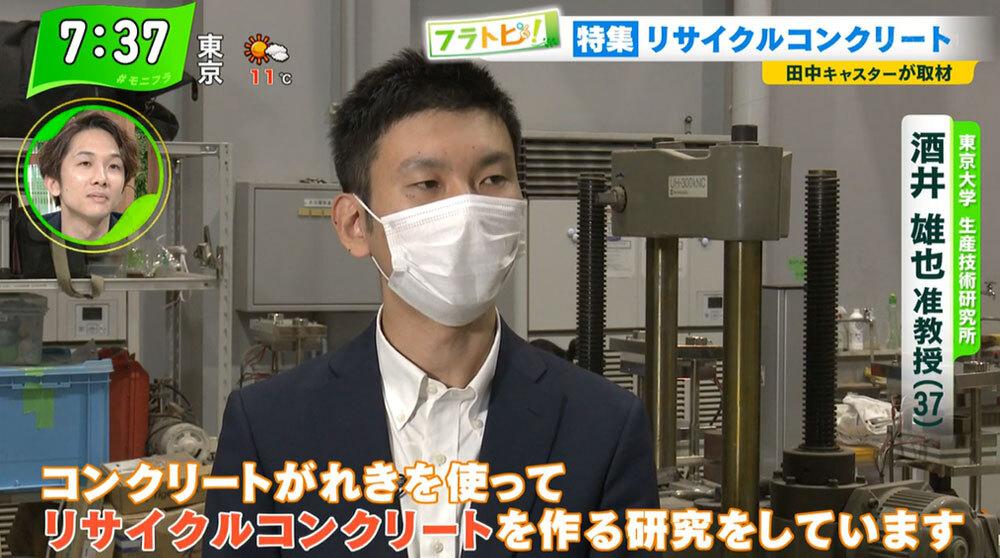A concrete that can be eaten appears!Surprising latest technology to make building materials from waste
A concrete that can be eaten appears!Surprising latest technology to make building materials from waste
TOKYO MX (9ch terrestrial) Morning news and information live program "Hori Jun Morning Flag" (every Monday to Friday 7: 00-). In the corner of "Flatopi!", Caster Yonan Tanaka interviewed "Recycling Concrete". ◆ Recycling concrete that is environmentally friendly. Concrete is used everywhere around the body, but the amount of "debris" generated in construction is about 30 million tons per year. "Recycling concrete" is a technology that reduces the environmental load of such concrete and reborn as a new concrete. Tanaka headed to the Laboratory of the University of Tokyo in Komaba, Tokyo to hear about the technology. I heard from Yuya Sakai of the University of Tokyo Production Technology Research Institute. In the lab, various construction materials are being researched and developed, one of which is a research that makes recycling concrete. Usually, concrete is made by mixing sand, gravel, water, and cement, but cement, which plays the role of adhesive, discharges many CO2 in the process of manufacturing. The amount is 4.1 billion tonnes a year worldwide. It is about 8 % of CO2 total emission. However, the raw materials for recycling concrete are only "concrete rises" and "abandoned wood". So how do you make it? Use a small device, which is a mixture of concrete welcome and abandoned wood in powder, put pressure on the machine while applying heat, and is completed in about 5 minutes. In that situation, Tanaka was surprised, "Are you already completed?" When I touched the freshly made concrete, Tanaka rounded my eyes, saying, "It's solidified. It was a powder until a while ago." When the strength is measured, the bending strength is 20MPa. This is about four times the existing concrete. Associate Professor Sakai explains the recycling concrete mechanism, saying, "Because the wood contains a lignin ingredient, it is a substitute for adhesive, so there is no need for new materials such as cement." ◆ Raw materials are vegetables ... Concrete that can be eaten, and this lab uses unexpected materials as construction materials. Developed new materials that can be used as building materials using discarded vegetables and fruits. Associate Professor Sakai says, "I think it is in sugar and dietary fiber contained in vegetables." It seems that the detailed mechanism is currently being studied, but if you add heat to the vegetables and compress it, the sugar inside will melt, which will enter the gaps in the dietary fiber, and it will be stronger. Although the strength varies depending on the raw material, it seems that some of them are four times the concrete. In addition, the ingredients are 100 % vegetables, and Associate Professor Sakai says, "I can eat it." "For example, we are considering using this material with this material and eating it when rescue supplies do not arrive," he said. Finally, the reason for this study was "While studying why concrete becomes stiff, I came up with the idea that wood could be used as an adhesive. It has an impact on the environment, including concrete. So, if we can use garbage that comes out of our lives, we think that it will be two birds with one stone by reducing garbage and protecting nature. " In a series of studies, the caster Jun Hori applauds, "Great research!" Mr. Masahiko Osawa, Assistant Professor, Nihon University, the same researcher, also praised, "It's the best," and said, "It's been a long time that concrete is bad for the environment, but that's being turned over now." increase. This is because not only this study, but also the development of concrete made by absorbing carbon dioxide is being developed. It's going to be the times. (Concrete is a super hot). " The studio had concrete made of vegetables, and everyone was touching and smelling, but he didn't know what the material was a little smell. While the strength is comparable to existing concrete, and the advantage of being eaten, the worrisome point is that it gets wet with water, but if you do waterproofing in the same way as wood, you can use it outdoors. 。 In addition, insects may come to vegetables only, but it seems that it can be avoided by putting ingredients that insects such as herbs and peppers are not good at. As for future issues, long -term durability is inferior to existing concrete, so it is necessary to verify in the future, but associate Professor Sakai has set a goal of building a whole house with only recycling building materials. rice field.

